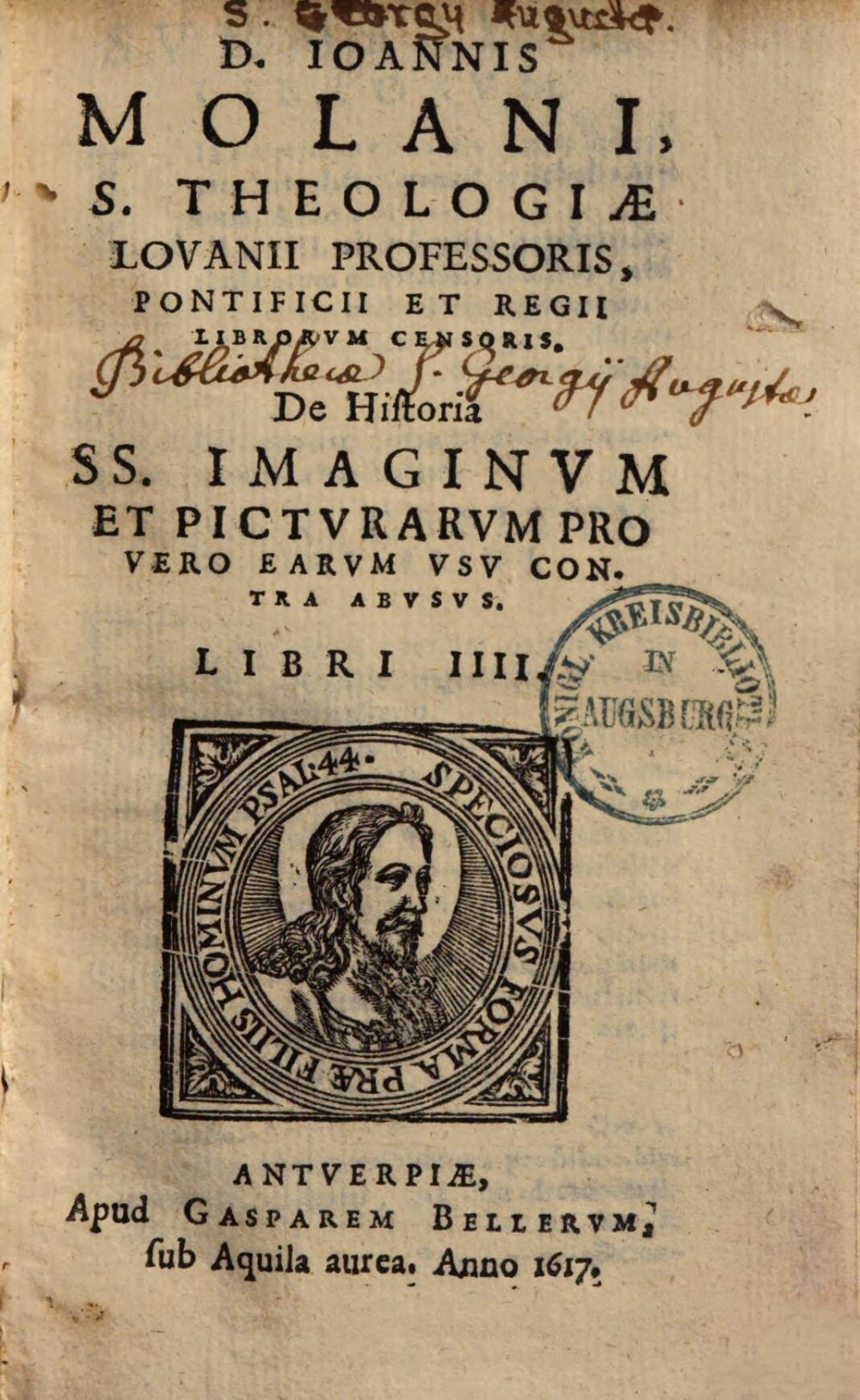
Augsburg, Staats- und Stadtbibliothek — Th H 1475. Digital Reproduction: München, Bayerische Staatsbibliothek, 2015.
Molanus calls for the removal of lascivious art from public areas by worldly authorities.
“In this light, I wish to quote a passage from Erasmus’ Institution of Marriage, which for good reason was not banned by the Tridentine Fathers, because with many weak minds the authority and judgment of Erasmus carry a great deal of weight: ‘It is not fitting’, he says, ‘to hear immoral words in the family, nor to find indecent pictures there. For a mute painting is a talkative thing and creeps slyly into the spirit and mind of man. Some adorn their rooms with turpid amenities, as if youth needed a stimulant to excite itself. Why denude in a painting what modesty would support to the look and which one never offers to the eyes children?’ With equal finesse, this same author writes in his Institution of the Christian man: ‘Asistotle is so persuaded that paintings and lascivious statues corrupt morals that he wants the laws and magistrates to take care to preserve them, lest one finds in the city some image inciting to debauchery. The language is addressed to the ears, the painting to the eyes; but the painting is much more talkative than the speech and often goes deeper into the heart of men. Is it necessary to recall the license of statues and paintings? What is most shameful to name is presented to the eyes. In the shops, in the market, these motives are publicly exposed to the eyes of all, who imbibe them willy-nilly, those eyes by which it was possible to excite Laomedontiade already made indifferent by age and Nestor despite his hernia. O negligence of laws and magistrates! The Philosopher is gravely mistaken, he who attacks the obscenity of images but excludes the gods, to whom the laws attribute debauchery! in my opinion, Aristotle thinks here of Venus and the naked Cupids, of the guardian of the gardens with the satyrs, of the phalluses of Bacchus, and of their festivities in which debauchery is solemnly displayed. O new religion of the philosopher! He allows the gods to have debauchery, where it would be particularly appropriate for it not to exist! Moreover, Aristotle wants youth to have no access to this kind of religious ceremony. Let us thank God that our religion is nothing but chaste and modest. But those who introduce a lack of modesty into what is naturally chaste sin all the more grievously. What need is there to see David in church at the window contemplating Bathsheba, and leading her into adultery. Or embracing the daughter of Herodiad dancing? These subjects may be taken from the sacred books, but when artists show women, so much debauchery is mixed in!'”
“Huc facit et illud Erasmi, quod ex institutione matrimonii Christiani, quia ea a Patribus Tridentinis non abs re damnata est, citatione mea conservare cupio, eo quod apud multos infirmos Erasmi authoritas et iudicium multum valeat. Quemadmodum inquit, ‘non decet in familia audiri sermonem lascivum, ita nex tabulas haberi convenit impudicas. Loquax enim res est pictura tacita et sensim irrepit in animos hominum. Turpitudinis deliciis quidam ornant sua conclavia, quasi inventuti desint irritamenta nequitiae. Membra quae verecundiae gratia celas ne videantur, cur in tabula nudas et nunquam ea pateris abesse a conspectu liberorum?’ Nec minus eleganter idem in institutione Christiani hominis, ‘Aristoteles, ait, adeo putat picturas statuasque, lascivas ad morum corruptelam facere, ut hoc velit per Magistratus publicis legibus caveri, ne quid Imaginum sit in civitate quod admoneat, turpitudinis: lingua loquitur auribus, pictura loquitur oculis; et multo loquacior est pictura, quam oratio et frequenter altius descendit in pectus hominis. Quid memorem quanta sit in signis ac picturis licentia? Pingitur et oculis repraesentatur, quod vel nominare sit turpissimum. Haex argumenta prostant publicitus, in tabernis ac foro, et volentium nolentium oculis ingeruntur, quibus incendi iam frigidus aevo Loamedontiades et Nestoris hernia possit. O legum et Magistratuum oscitantiam! Erravit autem graviter Philosophus, dum imaginum obscoenitatem undique profligans, excipit deos quibus leges attribuunt turpitudinem. Sentit opinor de Venere et Cupidinisbus nudis, de custode hortorum, de Satyris et Phallis Bacchi, in quorom sestis solenniter turpia agitabantur. O novam Philosophi religionem! In diis permittit turpitudinem, ubi maxime conveniebat abesse turpitudinem. Quanquam Aristoteles ab huiusimodi sacris vult atceri teneram aetatem. Agamus gratias Deo quod nostra religio nihil habet non castum et pudicum. At tanto gravius peccant, qui rebus natura castis, invehunt impudicitiam. Quid est necesse in templo depingere David contemplantem e fenestra Bethsabeam et ad stuprum evocantem, aut amplectentem ad se delatam Sunamitim, Herodiadis filiam faltantem; Argumenta sumta sunt e divinis libris, sed in ex primendis foeminis quantum admiscent artifices nequitiae.'”
Molanus 1996, 244-245.; David Freedberg, “Johannes Molanus on Provocative Paintings. De Historia Sanctarum Imaginum et
Picturarum, Book II, Chapter 42″, Journal of the Warburg and Courtauld Institutes, 1971, Vol. 34 (1971), pp. 229-
245.



